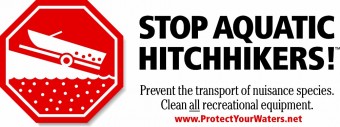An ad-hoc committee established in 2012. 
MISSION: Prevent the establishment and/or minimize the spread of invasive species in Ann Lake and related shorelines through observation, identification and eradication.
-
- Accomplish as much as possible through communication aimed at the mobilization and education of our riparian community
- Develop an expert referral network to which to submit suspicious biologic samples.
-
- Establish/maintain an observation network of volunteers from within our membership.
- Establish a protocol for presenting suspicious sightings upward from our network, organizationally through our committee to the board.
- Establish/maintain working relationships with other local lake associations and private/public environmental organizations to enhance our efforts; streamlining the development of educational aids and the reporting accuracy of suspicious observations.
Invasive Plant Mapping
Each summer, a team goes out on the lake and spends the day looking for aquatic invasive plants. We chart the data found each year (reports following). This allows us to compare what we find, year over year, and to ensure that Ann Lake is free of any aquatic invasive plant. Here is a video of the team in 2016.
[cincopa AsEAALOpcjAP]
Committee Reports & Articles:
- 2011 Newsletter
- Ann Lake Invasive Species Committee 2012 YR. End Report
- Local Infested Lakes and Boat cross traffic risk: 2012 survey
- Ann Lake Invasive Species Committee 2013 YR. Mapping Report
- Ann Lake Invasive Species Committee 2015 Yr. Mapping Report
- Ann Lake Invasive Species Committee 2016 Yr. Mapping Report
- Ann Lake Invasive Species Committee 2017 Yr. Mapping Report
- 2016 Report to Almira Township
Professional Lake Management (PLM) Reports:
- 2018 On-Site Lake Evaluation Record
- 2018 Aquatic Vegetation Summary
- 2019 On-Site Lake Evaluation Record
- 2019 Aquatic Vegetation Summary
- 2020 On-Site Lake Evaluation Record
- 2020 Aquatic Vegetation Summary
- 2021 Lake Evaluation Record
- 2022 On-Site Lake Evaluation Summary
- 2023 On-Site Lake Evaluation Summary
Invasive shoreline plants found in Michigan:
- Phragmites – an aquatic tall, perennial wetland grass that can grow to 15 feet in height. Typically grows in coastal and interior wetlands, lake margins, roadside ditches, and other low, wet areas.
- Coltsfoot – an aggressive shore plant, alien, and invasive plant currently observed only on Glen Lake’s eastern shore. Picture, Leaves.
- Purple Loosestrife – an invasive wetland plant that is beautiful, but dangerous. Imported for ornamental and medicinal uses, it poses a serious threat to wetlands because of its prolific reproduction.
- Invasive Knotweed – Two non-native invasive plants that have been gaining a foothold in recent years in Northern Michigan are Japanese Knotweed and Giant Knotweed. Knotweeds grow best in full sun and can be found among streams and river banks, wetlands, and woodland edges.
Invasive aquatic plants and animals found in Michigan:
Ann Lake does NOT have any of these except for zebra mussels.
- Eurasian milfoil – an aquatic plant that will fill a lake surface from shore to shore.
- Hydrilla – forms dense mats of vegetation that interfere with recreation and destroy fish habitat.
- Starry Stonewort – an aquatic plant currently not seen in the upper lower peninsula. Confirmed in 55 Michigan Lakes.
- Curly pond-weed – an aquatic plant generally grows in 3-10 feet of water.
- Quagga Mussels – a mussel related to the Zebra Mussel which is the only invasive in Ann Lake that we know.
- Spiny Water Flea – invasive zooplankton that eat food source for fish.
- Fishhook Water Flea – invasive zooplankton that eat food source for fish.
- VHS – a virus that will infect fish and wipe out a whole lake fish resource.
- Rusty Crawfish – competitive with native specie crustacean.
Web Links:
- To help identify an invasive plant, use the Michigan Invasive Organization site and on the common name dropdown menu, select the plant you would like to identify. Then scroll down on the right side of the plant page. Under web links there is a selection called training guide for all put curly pondweed. It walks you through how to identify each plant.
- Get involved; report invasive species at http://natureiscalling.org/invasive/isn-report-sightings/ or post a message on this page!
- Get Involved with the Grand Traverse Conservation District: http://natureiscalling.org/invasive/get-involved/
- Stop aquatic nuisance species: http://www.protectyourwaters.net/
- View maps showing historical land use and vegetation patterns across the state of Michigan.
- Learn about invasive plants in Michigan, or download the Field Identification Guide to Invasive Plants in Michigan’s Natural Communities.
- Explore research from Michigan State University on how native plant landscapes increase regional agricultural yields and reduce pest control costs.
- Learn about invasive phragmites control efforts in Grand Traverse and Leelanau Counties.
- Find out which plants are native to where in the United States by searching on any common or scientific name. For Michigan specific information, explore Michigan Flora
- Learn more about how various native plants perform in landscaped settings by visiting either the Lady Bird Johnson Wildflower Center or the Missouri Botanical Gardens and searching by common or scientific name. Be sure to check geographic ranges of plants you explore on these sites, as both provide information for plants that would not thrive in Michigan landscapes.
- View maps showing historical land use and vegetation patterns across the state of Michigan.
- Find sources for regional native plants within the state of Michigan.
- Learn how to get your backyard certified as wildlife habitat.
- Learn about low-impact development methods, the gold standard for new development.
